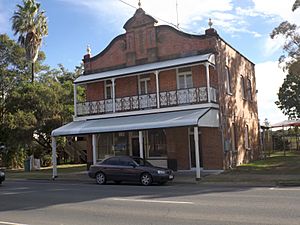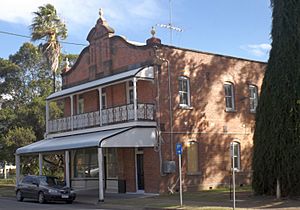Whitehouse's Bakery facts for kids
Quick facts for kids Whitehouse's Bakery |
|
|---|---|

Whitehouse's Bakery, 2015
|
|
| Location | 91 Patrick Street, Laidley, Lockyer Valley Region, Queensland, Australia |
| Design period | 1900 - 1914 (early 20th century) |
| Built | 1904 - 1905 |
| Official name: Whitehouse's Bakery (former), Laidley | |
| Type | state heritage (archaeological, built) |
| Designated | 21 October 1992 |
| Reference no. | 600656 |
| Significant period | 1900s (fabric) c. 1905-1980s (historical use) |
| Significant components | kitchen/kitchen house, trees/plantings, oven, residential accommodation - flat/s |
| Lua error in Module:Location_map at line 420: attempt to index field 'wikibase' (a nil value). | |
Imagine a place where delicious bread and treats were made for almost a century! That's Whitehouse's Bakery in Laidley, Queensland. This old building, built between 1904 and 1905, used to be a busy bakery. Today, it's a special heritage site, recognized on the Queensland Heritage Register since 1992. It stands at 91 Patrick Street in the Lockyer Valley Region.
Contents
A Look Back: The Bakery's Story
The Whitehouse's Bakery building is a large, two-story brick building. It was built around 1904-1905 for a local farmer and baker named Charles James Whitehouse. This was actually the second bakery building Charles built on this spot. He had bought the land in 1885, and the new brick building replaced an older wooden one. An architect from Ipswich, William Haenke, designed this impressive building.
Laidley's Growth in the Early 1900s
When the bakery was built, the Lockyer Valley was a very successful farming area in Queensland. This success led to a building boom in Laidley. The town almost doubled in size! Many older wooden buildings were replaced with strong brick ones. Other new buildings included the Exchange Hotel (around 1902), Neilson's Central Hall (1902), Geismann's buildings (1902), and Wyman's new store (1906). Laidley even got its own town council in 1902, separate from the Laidley Shire Council.
Charles James Whitehouse: The Founder
Charles James Whitehouse was born in London in 1840. He traveled a lot when he was young, even sailing to India. He worked in Australia as a miner and farmer. In 1867, he married Sarah Ann, who was from Laidley. They had six children.
For 18 years, Charles worked for the Queensland Railways as an engine driver. But in 1885, he decided to open a business in Laidley as a baker and confectioner. He focused on his bakery for 11 years. Later, he retired to his farm, which his sons, CJ (junior) and Benjamin, took over. They mainly grew lucerne and raised dairy cows.
Family Ties and Challenges
The bakery faced challenges, including floods. In 1893, a big flood badly damaged Whitehouse's Bakery. After this, Charles Whitehouse asked Edward Mann to help run the business.
In 1904, Charles's son, Benjamin Whitehouse, took over managing the bakery. This was around the time the new two-story brick building was constructed. Even though Benjamin was managing it, Edward Mann was often the one actually baking the bread.
Charles James Whitehouse passed away in 1920. The bakery property then went to his sons, CJ Whitehouse Jnr and David Hansford Whitehouse. The Whitehouse family owned the property for about 65 years.
The Mann Family's Long Connection
In 1950, the bakery was sold to Jack Mann. Jack was Edward Mann's son and had already been renting the property. When Jack Mann died in 1988, his wife, Alice Maud Mann, became the owner. She lived there until 1995. Alice Mann said that she and Jack had been involved with the bakery for a total of 67 years!
Alice also shared that floods damaged the bakery two more times, in 1959 and 1974. The external ovens at the back of the property were so damaged in 1974 that they couldn't be fixed. You can still see the remains of these brick ovens today.
New Uses and Restoration
After Alice Mann moved out, the property was sold to Ruth Brunton, Alice's sister-in-law. Later, it was sold to Julie Brimblecombe, and the old bakery building was used as a space for arts and crafts. By early 2001, the building was empty.
In June 2001, important repair work was done on the southern wall of the kitchen area. This work was funded by a special grant. The wall had big cracks and was leaning, so workers carefully took it apart brick by brick. Then, they rebuilt it using the original bricks and the original design.
The last time the property changed hands was in September 2001, when Mr. Geoffery Hand bought it. At that time, it was still empty.
What the Bakery Looks Like
The old Whitehouse's Bakery building stands on the western side of Patrick Street. It's part of a group of impressive old commercial buildings in the main part of Laidley town.
Building Features
The bakery is a two-story building made of red bricks. On the ground floor facing Patrick Street, it has large shop front windows. The upper floor has a narrow verandah with decorative cast iron railings and an awning that covers the footpath. The roof is sloped, and the front of the building has a fancy decorative wall called a parapet, which shows off an art-nouveau style. There are also two single-story brick buildings at the back.
Front of the Building
The front of the ground floor has four wooden posts that support the awning. There are two large display windows that stick out a bit, like angled bays. These windows are on either side of a central doorway, which used to be the public entrance to the bakery. Above this door is a rectangular window called a fanlight. At the northern end of the front, there's another doorway with an arched fanlight, which was a private entrance to a separate room.
Upper Level and Decorations
The upper level has decorative cast iron panels on the verandah railing. The verandah has its own curved, corrugated-iron awning, supported by four slender wooden columns. The edges of this awning are decorated with a cast iron frieze.
The top of the building has a special decorative wall called an Anglo-Dutch parapet. It has three round decorations on top, and in the middle, it proudly shows the year "1905." Two tall, flat columns, called pilasters, extend down from this middle part. They are decorated with rectangular blue tiles. The overall look of the parapet is in an art-nouveau style. The front wall of the verandah is also made of brick and has three double French doors with rectangular fanlights.
The sides of the building have sliding windows on both levels, and the buildings at the back also have them.
Back Buildings and Ovens
The two-story part of the bakery has a single-story brick room attached to its rear southern corner. This room used to be where they prepared food for the bakery. You can get into it through a door on the northern side, which opens onto a patio made of original bricks. These bricks even have heart-shaped marks! This room is attached to the main building but doesn't have an inside door connecting them.
Behind this first building, there's a second separate building, connected only by a covered walkway called a breezeway. This second building has a sloped roof and a large chimney at the back. This chimney served two big bread ovens. Inside, you can still see the iron doors to these ovens on the back wall. However, the brick insides of the ovens, which used to stick out from the back wall, are now in ruins.
Inside the Bakery
Inside the two-story part of the bakery, you'll find wooden floors, high ceilings, and walls made of wooden VJ panels or plastered brick. There are four rooms on the ground floor. The main serving area is a large rectangular room that runs parallel to Patrick Street. The wide wooden floorboards at the northern end are a bit curved from all the people standing there over the years at the service counter.
Next to this room is a smaller room, and directly behind it is another room of the same size. The largest room is in the center of the back part of the building and has a big wooden staircase leading to the upper level. The wooden railings on the staircase have a unique design.
The upper level has three bedrooms and one bathroom. Two of the bedrooms have access to the front verandah through the French doors. The internal doorways have rectangular fanlights with decorative wooden patterns. The walls and ceilings are made of wooden VJ panels, and all the rooms have decorative ceiling roses. Both the inside and outside of the building, including the smaller buildings, are still very much like they were originally.
The bakery is surrounded by a small garden with old plants and a wooden fence. A large palm tree on the north-east corner of the building looks very old.
Why Whitehouse's Bakery is Special
Whitehouse's Bakery (former) in Laidley was added to the Queensland Heritage Register on 21 October 1992 because it meets several important criteria.
Showing Queensland's History
This building helps us understand how Queensland's history unfolded. Its strong construction around the early 1900s shows a time when Laidley was growing and becoming more stable economically. This was a common trend in many rural towns across Queensland back then.
A Great Example of an Old Bakery
The former bakery building is a good example of what a turn-of-the-century bakery looked like. The brick ovens and other parts of the bakery are still there. This helps us clearly see how bread was made in the past.
Beautiful and Important to the Town
The old bakery is also important because it's a beautiful and well-designed building in the center of Laidley. It adds a lot to the look of the main street, Patrick Street. Its design, decorations, and the surrounding garden (especially the old palm tree) all make it a very special place to look at.
A Local Landmark
This place has a strong connection with the people of Laidley. It has been a local landmark and a place that served the community for almost a hundred years.
Connected to Important Families
The bakery has a long history with two important Laidley families: the Whitehouse family and the Mann family. They were directly involved in building and running the local bakery. Because of this, they were very important members of the Laidley community from its early days.
Images for kids




